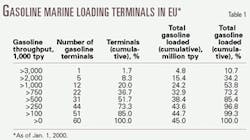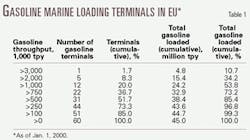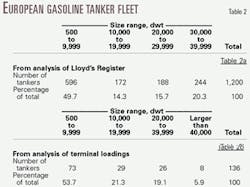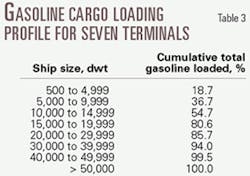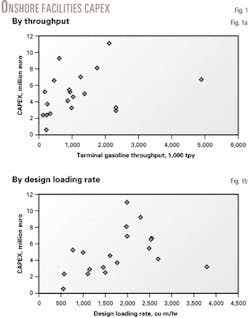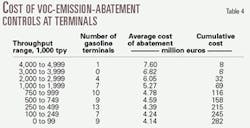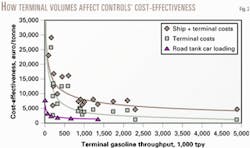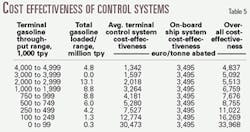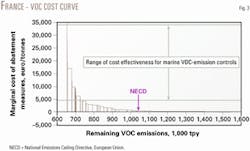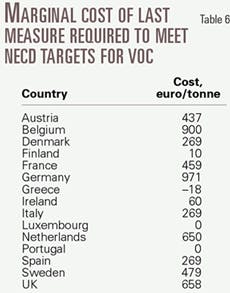A study of emission controls for non-methane volatile organic compounds (VOCs) at European marine gasoline-loading terminals shows that such controls would not be cost-effective even for terminals with the very largest throughput.
The European Union's National Emissions Ceiling Directive sets targets for nonmethane VOCs in European maritime countries. The study compared the cost of marine control to that of the most expensive alternative measure that could be applied to meet those targets at minimum cost.
CONCAWE, a Brussels-based European organization representing oil companies' interests for health, safety, and the environment, conducted the study and reported in late 2002 the results and conclusions (CONCAWE Report 6/02).
The study addressed both the size of the fleet of sea-going tankers used to transport gasoline and the size and profile of the marine terminals where they load in 15 members of the EU, as of Jan. 1, 2000.
It estimated the level of uncontrolled VOC emissions during gasoline loading onto these tankers. And it established the costs of installing vapor-collection systems aboard the ships and emissions-control systems at the onshore terminals. Emission and cost data from an earlier study on the subject (CONCAWE Report 92/52) were updated and used to estimate the overall cost-effectiveness of controls.
Major findings
The report said that total gasoline loaded onto sea-going tankers at 60 gasoline marine loading terminals in the EU-15 is about 45 million tonnes/year (tpy). The tanker fleet consists of about 1,250 tankers, most smaller than 50,000 dwt (metric) with 80% of the gasoline loaded into tankers smaller than 20,000 dwt.
It stated that estimated uncontrolled VOC emissions from marine gasoline loading are 12,575 tpy. With total man-made VOC emissions in the EU-15 set by the EC at 9.9 million tonnes in 2000, emissions from ship loading of gasoline at the 60 terminals comprise only 0.13% of total emissions.
When the study began, no VOC-emission-control system had been installed in the EU-15 for gasoline loading of sea-going tankers. The study noted, however, that several such systems had been installed in the US to comply with legislation.
It pointed out that installing vapor collection and emission controls at marine loading "introduces additional potential hazards from overfilling and over and under-pressurization of tanker cargo tanks and ignition propagation within vapor lines."
Since Report 92/52, the International Maritime Organization (IMO) has published standards that address these issues.
The 2002 study reported that costs of installing a VOC-emission-control system for loading gasoline onto sea-going tankers vary significantly at sites with similar throughputs because of site-specific influences. For example, the average cost for a 1.5-million-tpy (gasoline) terminal is more than 5 million euros but could range from 2 to more than 10 million euros. The cost for the largest reported installation in the US was the equivalent of 19 million euros.
Total costs to control emissions during gasoline loading of these tankers are about 575 million euros and consist of 282 million euros to install gasoline-vapor emission controls at the 60 loading terminals in the EU-15 plus 293 million euros conversion costs for the tanker fleet.
The shore-side VOC-emission-abatement systems cannot operate without the onboard tanker vapor-collection systems being installed, said the report. If only some tankers have the systems installed, the amount of vapor returned ashore is less and the cost-effectiveness of the shore-side facilities correspondingly worsens.
The overall cost-effectiveness can only be calculated, the report said, if it is assumed that all ships have vapor-collection systems installed because almost any vessel designed for gasoline transportation could load at any terminal.
The overall cost-effectiveness of marine loading VOC-emission controls, therefore, is the sum of the cost-effectiveness of the investments for the shore-side and onboard vessel equipment.
The overall average cost-effectiveness of VOC emission controls, the report said, would be about 4,837 euros/tpy of emissions abated to more than 30,000 euros/tpy abated as the terminal throughput decreases. For example, for a terminal with a gasoline throughput of 1.5 million tpy, the overall average cost-effectiveness would be almost 6,760 euros/tpy abated.
The report reviewed facilities in the EU-15 where gasoline is loaded onto sea-going tankers and the ship fleet, including "entrepot" terminals where gasoline is off-loaded, stored, then subsequently reloaded onto ships. These latter facilities expanded coverage from those operated by oil companies to those owned by independent tank storage companies.
The report also dealt only with the control of VOC emissions generated during gasoline loading onto sea-going tankers. VOC emissions may also occur during such other marine operations as ballasting after cargo discharge, venting during transportation, and cargo tank cleaning.
Previous studies; legislation
CONCAWE has issued several reports on VOC emissions and their control in the downstream oil industry.1-5
Report 90/52 provided an overview of the gasoline distribution system and focused on costs associated with controlling emissions in the road and rail supply chain.4 To complement that study, Report 92/52 reviewed the costs and cost-effectiveness of installing VOC- emission controls for gasoline loading onto sea-going tankers and inland waterway barges.5
That report was based primarily on project studies because no ship loading and only two barge-gasoline-loading VOC-emission-control systems had been installed in EC countries by 1990 when the cost data were collected.
Since then, several US sea-going vessel loading terminals have been equipped with gasoline VOC-emission-control systems to comply with state and federal legislation.
The study that is the subject of this article updates Report 92/52. It takes into account experience gained in the US on marine loading VOC-emission controls with installed gasoline systems, in Europe with systems to control benzene emissions, and from new project studies.
Initial results of this study have appeared previously.6 7 This report updates both the number of terminals and the estimated size of the tanker fleet following more recent studies.
In the US, both state and federal legislation mandate VOC-emission controls during ship loading of gasoline.8 The federal Clean Air Act requires use either of vapor recovery achieving 95% emission reduction or of destruction techniques achieving 98% reduction. The law requires emission-control systems at terminals loading more than 10 million bbl/year of gasoline (about 1.2 million tpy).
European Directive 94/63/EC9 on the control of VOC emissions mandates installation of emission controls for gasoline loading of inland-waterway barges at terminals where more than 150,000 tpy of gasoline are loaded. Ship-loading VOC- emission controls were not included because the EC was awaiting revision of IMO's MARPOL Convention with the addition of a new Annex VI on the prevention of air pollution from ships. (MARPOL refers to the International Convention on the Prevention of Pollution from Ships.)
Article 9 of Directive 94/63/EC, however, requests proposals for amendments, including VOC-emission-control systems for ship loading, to accompany the first report on the implementation of the directive. The EC commissioned a report from AEA Technology PLC10 as input to the decision-making process on amending the directive.
The new Annex of the MARPOL Convention11 sets out the process by which port states must inform others of their intentions to install marine VOC-emission controls. It does not stipulate which cargoes or sizes of ships would be affected.
The revision was approved in September 1997 but will not enter into force until 12 months after ratification by 15 port states with a combined merchant fleet of no less than 50% of the gross tonnage in the world.
A lengthy period before ratification of the new Annex is under way.
Vessels; data collection
The CONCAWE report last year stated that information had been collected on ship-loading facilities from both member companies of CONCAWE and the Federation of European Tank Storage Associations (FETSA).
Data were obtained for 60 terminals in the EU-15 that load gasoline onto sea-going vessels. These include loading facilities at both refineries and entrepot terminals. This compares to 67 terminals identified in CONCAWE Report 92/52 report.5 That report, however, included barge-loading terminals but excluded storage terminals owned by non-oil companies.
A total of 45 million tonnes of gasoline was loaded during 1999 onto ships at the 60 loading facilities identified in this study, which represents approximately 33% of gasoline produced in the EU.12
Table 1 gives the size profiles of these terminals.
Tankers that transport gasoline vary in size from a few hundred metric tonnes to about 70,000 dwt. Some tankers may be on long-term charter to the company operating the loading facility and thus may load there frequently. Others on spot charter may load there only occasionally.
Because of the international nature of gasoline supply and trading, almost any vessel of the appropriate size and designed for gasoline transportation could load at a facility.
Because of the use of "flags of convenience," said the CONCAWE report, many sea-going tankers loading in Europe are not registered within an EU-15 country, making it difficult accurately to identify how many tankers could be involved in European gasoline trade.
Estimating the number of vessels that may load gasoline at European marine terminals required analyses in two ways.
The initial method was to analyze the tanker data in the Lloyd's Register of Ships.13
This analysis led to a conservative estimate of the potential fleet that could load gasoline at European terminals at about 600 tankers. Of these, 100 were assumed to have inert-gas systems (IGS) installed. When a tanker has such a system, it may be possible to modify the inert-gas piping to act as a vapor-collection system.
The second analysis was of tanker-loading data (Table 2a).
This analysis collected details on all the tankers loading gasoline at seven terminals over a 12-month period 1998-99, two of these terminals being at refineries in the Mediterranean, four at Northern European refineries, and one was an entrepot on the North Sea.
During the 12 months, a total of 3.6 million tonnes of gasoline were loaded into 136 vessels. Table 2b shows the size profile of these tankers.
This profile is weighted more towards the smaller tanker size, said last year's CONCAWE report. The size of the largest vessel loading was 70,900 dwt, but this vessel loaded only once. No other vessels were larger than 50,000 dwt.
Of the 136 vessels, 65 were "product" or "crude/ product" tankers. The other tankers had no cargo categorization, and therefore more than 50% of the tankers loading at these terminals would have been missed by the first method of fleet size analysis of Lloyd's Register of Ships.
That initial analysis had recognized that limiting the tanker type categorization would lead to an underestimate of the fleet. The details of the actual tankers loading at the seven terminals, therefore, permitted a more realistic estimate.
On the assumption that the 65 tankers were part of the initial estimate of 600 product and crude-product carriers, extrapolating to take account of the other 71 tankers leads to an estimate of the potential fleet that could load gasoline at European terminals of approximately 1,250 tankers (from 600 x [136/65] and rounding down).
Of the 136 tankers, 38 were fitted with inert-gas systems, equating to 28% of the vessels. This compares with the 17% assumed in analysis of Lloyd's Register.
The IMO International Convention for the Safety Of Life At Sea (SOLAS)14 specifies which tankers require IGS to be installed. Tankers smaller than 20,000 dwt do not require IGS. Table 2b confirms that 75% of the vessels were smaller than 20,000 dwt. In practice, 4% of these small tankers had IGS installed.
The CONCAWE report therefore assumed that the approximate size of the gasoline sea-going tanker fleet in European waters is 1,250, of which 350 (28%) are fitted with inert-gas systems.
The total number of loadings reported at the seven terminals was 1,766. Thus, said the report, the average number of loadings was 13/year/tanker; the maximum reported loadings was 122/year/tanker. This latter vessel was a coastal tanker supplying gasoline to local terminals for onward transportation by road.
The average gasoline cargo made up 38% of the vessel deadweight tonnage. The average total cargo loaded (gasoline plus other products, e.g., diesel fuel) made up 62% of the vessel tonnage.
Of the 136 ships, only one loaded at three of the seven terminals and eight at two terminals. All the other 127 tankers loaded at only one of the terminals.
Table 3 shows the loading profile for the 136 tankers.
More than 80% of the gasoline was loaded onto vessels smaller than 20,000 dwt. Because such tankers need have no IGS, under the IMO SOLAS Convention,14 extensive modifications to permit vapor collection would be required. (A subsequent section addresses the costs of installation.)
VOC emissions
The CONCAWE report explained that when a tanker arrives at a terminal, unless the tanks have been gas freed or cleaned, the empty cargo tanks contain the preloading vapor, the result of the mixing of the vapor left in the tank from the previous cargo with the air drawn into the tank when that cargo was discharged.
The concentration of the preloading vapors thus depends on the volatility of the previous cargo. Even with a volatile product, however, the concentration will be low, said the report. A previous gasoline cargo, for example, will result in an average preloading concentration of about 3% (vol).5
When a cargo of gasoline is loaded into a tank, the concentration of the vapor displaced changes with time.
The vapors evaporating from the gasoline during the loading are in a layer on the surface of the cargo, its thickness depending on the loading rate and turbulence. Over the first two-thirds of the loading period, the vapors vented are similar to the preloading vapors because there is virtually no mixing of the vapors from the new gasoline load with those in the top and middle sections of the tank vapor space.
Also, said the report, vapors are within the explosive range during this period. Towards the end of loading, the concentration of the vented vapors increases almost to saturation as the vapor layer on top of the gasoline is displaced into the vent.
The uncontrolled VOC emissions during loading of a typical European gasoline with a true vapor pressure (TVP) of 35 kPa onto a typical sea-going tanker can be calculated with an emission factor developed by the US American Petroleum Institute of 0.034% vol/vol.15
Thus for a total of 45 million tpy of gasoline loaded, the uncontrolled emissions equal 12,575 tpy, assuming the density of gasoline is 730 kg/cu m and that of condensed gasoline vapor is 600 kg/cu m.5
With estimated total man-made VOC emissions in the EU-15 of 9.9 million tonnes in 2000,16 the emissions from ship loading of gasoline at the 60 terminals identified are about 0.13% of the total.
Control options, equipment
The CONCAWE report stated that to permit VOC-emission control during loading, vapor piping must be installed on the tanker so that the tank vents can be connected to a VOC-emission-control system ashore.
Trials are under way with vapor-control systems aboard shuttle tankers carrying crude oil. There are currently, however, no tankers equipped with such systems for controlling gasoline cargo emissions.
When an empty cargo tank is being loaded with product, vapor displaced by the rising liquid must be removed to prevent a build up of pressure in the tank.
Tankers have a variety of tank venting systems. The most basic venting technique is to load the tanks with the hatches open. Referred to as "open loading," this permits the level of the cargo to be observed and measured with a manual gauging tape lowered through the opening.
"Closed loading" involves keeping all tank openings and hatches closed. During loading, vapors are displaced through a vent system. Closed loading is essential to permit vapor collection from a tank and allows the common vapor pipework to be connected to a shore-side VOC-emission-control system.
In addition to the cost of installing vapor-piping systems, however, conversion to closed loading also requires installation of automatic level and pressure monitoring and alarm systems, said the report.
- Individual vents on each tank close to the deck level but designed to emit vapor at high velocity and disperse it from near the deck.
- High level (masthead) vents, either dedicated to each tank to prevent comingling of vapors or common to several tanks.
Vent systems can consist of:
On those tankers required to have IGS, the inerting of the vapor space above the product ensures that the vapors in the tanks are well outside the flammable range. Where a tanker has such a system installed, it may be possible to modify the IGS piping to act as a common vent piping system.
IMO has produced a standard for the design, construction, and operation of vapor-collection systems on sea-going tankers.17
In addition, to ensure compatibility of shore-side and onboard tanker vapor connections, the Oil Companies International Marine Forum (OCIMF) has published recommended sizes for vapor manifolds for tankers larger that 16,000 dwt.18
Technologies for the abatement of shore-side emissions to atmosphere from gasoline loading operations include:
- Routing the vented vapors back to the storage tank from which the gasoline cargo was pumped, referred to as "vapor balancing," in which the volume of vapor displaced back to the tank about equals that of the gasoline removed. This technique can only be used where storage is in a fixed-roof tank.
- Thermal oxidation of the vented vapors in process heaters, specially designed incinerators or flares.
- Recovery of the vented hydrocarbon vapors in a vapor-recovery unit (VRU) using such technologies as adsorption, absorption, membrane separation, and condensation. VRUs commonly use a combination of technologies, e.g., adsorption to separate the VOCs from the air and absorption to recover the hydrocarbons.
Of 120 ship-loading gasoline VOC-emission-control systems installed in the US, the types consist of vapor balancing (9), thermal oxidation (87), and vapor recovery (24).8
Although thermal oxidation systems produce combustion products directly at the facility, other abatement technologies such as vapor recovery use electricity and thus also produce CO2, albeit indirectly, at the power-generation plant.
Loading marine vessels with flammable products at relatively high pumping rates brings with it certain hazards, e.g., spills due to overfilling, with the consequent potential for fire or explosion.
Application of VOC-emission controls during gasoline loading may increase the probability of these hazards and also introduce new ones. Since Report 92/52, IMO has issued standards for VOC-emission-control systems that address safety.17 These standards have been developed for the design, construction, and operation of both vapor-collection systems on tankers and VOC-emission-control systems at terminals.
Shore facility, vessel costs
The collected terminal data showed, said the CONCAWE report, that no VOC-emission-control system had been installed in Europe for ship loading of gasoline. To establish cost data, therefore, information was obtained on gasoline systems installed in the US, on those for benzene-emission controls in Europe, and from project cost estimates.
Fig. 1a shows how reported capital expenditures (CAPEX), adjusted for inflation, for VOC-emission-control systems vary widely for systems with similar throughputs.
A primary factor in the size of a system is the vapor flow rate, which depends on the loading rate, the vapor evolution from the gasoline being loaded, and any additional gas added to the system (e.g., enrichment gas).
Fig. 1b shows how reported CAPEX widely varies for the same design loading rate. This is because the cost of a VOC-emission-control system depends heavily on such site-specific issues as:
- Number of loading berths connected to the system.
- Distances between the berths and the shoreline.
- Length of vapor line to the location of the emissions-control unit.
- Need for blowers to assist vapor flows over long distances.
- Number and level of redundancy of measurement, alarm, and safety systems.
- Whether the system has to handle both inerted and non-inerted vessels.
- Whether tankers containing non-gasoline pre-loading vapors, e.g., chemicals or crude oils containing H2S, load at the site.
- Whether additional gas is added to the vapor to reduce the risk of ignition propagation along the vapor-collection lines.
- Where a VRU is installed, the distance between the unit and appropriate product storage tanks for the return of recovered product.
The CONCAWE report said that US experience has shown that the average cost of the proprietary equipment accounts for less than 25% of the total cost of a marine VOC-emission-control system.19
It should be noted that the cost data analyzed do not include a number of outliers. For example, the cost for the largest reported installed facility in the US is 19 million euros. In addition, systems where the loading facility is not connected directly to the shore (e.g., offshore loading "islands") have not been considered.
The CAPEX for these will be significantly higher than for systems installed onshore.
The data in Fig. 1a allow the average cost per terminal per gasoline throughput range to be determined (Table 4).
The average cost for a 1.5-million-tpy facility is about 5.3 million euros. Considering the scatter of cost data in Fig. 1a, however, the cost could range from 2 million euros to more than 10 million euros.
Table 4 shows that the estimated cost to install VOC-emission controls at all 60 marine gasoline loading terminals identified in the EU-15 will total 282 million euros.
To permit vapors to be collected during loading and passed to the shore-side VOC-emission-control system, sea-going tankers will need to have vapor-collection pipe work onboard. The costs to fit this will depend upon whether the tanker has closed loading or IGS or both.
The latter, for example, could be used as the vapor-collection system during loading, providing the piping size is adequate.
The costs of modifying sea-going vessels vary considerably. Reported costs from both actual retrofits and project estimates compare well with the costs identified in the previous CONCAWE Report 92/52, adjusted for inflation.
These are 275,000 euros for a vessel without inert gas and 130,000 euros for a vessel with inert gas.
An earlier discussion established that a conservative estimate for the fleet of tankers transporting gasoline in European waters is about 1,250, of which 350 have an IGS installed already.
The estimated total cost to retrofit the 1,250 vessels will thus be of the order of 293 million euros.
Cost effectiveness
Determining whether investments are justified requires comparing options, said the report. The criterion used is "cost effectiveness," defined as the annualized cost (euro/tpy of emissions abated).
Shore-side VOC-emission-abatement systems cannot operate without the onboard tanker vapor-collection systems being installed. If only some tankers have the systems installed, the amount of vapor returned ashore is less and the cost-effectiveness of the shore-side facilities correspondingly worsens.
Because of the international nature of gasoline supply and trading, almost any vessel designed for gasoline transportation could load at a terminal, assuming that the berths were designed for that size of tanker.
The overall cost-effectiveness, therefore, can only be calculated if it is assumed that all ships have vapor-collection systems installed. The overall cost-effectiveness of marine loading VOC- emission controls, therefore, is the sum of the cost-effectiveness for the shore-side and onboard vessel equipment.
The average cost-effectiveness of a VOC-emission-control facility at a shore-side terminal can be calculated from the emission reduction achievable, the annualized cost of the capital investment, and operating and maintenance costs.
No allowance has been made for tax incentives or for the untaxed benefit associated with the recovered vapors. This is because the majority of gasoline loaded into ships is duty-free and the untaxed value of the recovered vapors is small.
Using an capital charge of 15%/year allows a comparison with earlier studies done in the Auto Oil I program, since it is based on a similar internal rate of return (IRR) of 7%.
The operating and maintenance costs have been taken to be 5% and 2% of capital, respectively.
Fig. 2 plots the average cost-effectiveness of abatement (euros/tonne emissions abated) for VOC-emission-control systems either planned or installed at the 20 terminals where costs have been reported.
The overall cost-effectiveness of the total vessel onboard investments can be calculated from the total emission reduction achievable if all ships and terminals were equipped for vapor-emission controls and the total vessel-retrofit costs.
A capital charge of 15%/year has been used here as well. As the onboard systems consist only vapor piping and associated components, the additional onboard operating and maintenance costs will be low.
For the CONCAWE study, these costs were assumed to be zero.
Using total uncontrolled gasoline emissions from ship loading of 12,575 tpy and a total ship retrofit cost of 293 million euros gives the cost-effectiveness for the vessel onboard equipment of 3,495 euros/tonne emissions abated.
The cost effectiveness of the total investment, therefore, derives from summing the cost-effectiveness figure for the vessel onboard costs with that of the shore-side facility costs. Fig. 2 shows the average overall cost effectiveness of abatement plotted against terminal throughput. Table 5 shows the average cost-effectiveness per throughput range.
These data show that the average overall cost-effectiveness ranges from 4,837 euros/tonne emissions abated for the largest facilities to almost 34,000 euros/tonne emissions abated for a terminal loading 50,000 tpy gasoline.
For comparison, CONCAWE has determined that the average cost effectiveness for Stage 1 vapor recovery on road loading and deliveries, including the cost of modifying the road tanker fleet to be 2,630 euros/tonne emissions abated.4
Fig. 2 shows the average cost data, adjusted for inflation.
Comparison
The CONCAWE report stated that these costs must be seen in comparison with other available control measures.
With France as an example, Fig. 3 was developed from the International Institute of Applied Systems Analysis (IIASA) cost curve from the institute's Regional Air Pollution Information and Simulation model (RAINS).
About 80 control measures are ranked from lowest to highest cost per tonne of VOC abated. Each individual measure is shown as an open bar. The width of each bar corresponds to the emission reduction achieved by that measure.
Although France is shown here, the IIASA cost curves for other countries are similar.
To provide for ready comparison, the cost effectiveness of marine vapor recovery for gasoline loading appears as a range on Fig. 3. In addition appears the emission-ceiling target for France in the National Emissions Ceiling Directive (NECD).
Table 6 lists the marginal cost of the last measure in the sequence required to meet the national VOC NECD targets10 for the 15 EU countries.
References
1. Hydrocarbon emissions from gasoline storage and distribution systems. Report No. 85/54. CONCAWE, Brussels, 1985.
2. Volatile organic compound emissions in Western Europe: control options and their cost-effectiveness for gasoline vehicles, distribution and refining. Report No. 6/87. Brussels: CONCAWE, 1987.
3. Cost-effectiveness of hydrocarbon emission controls in refineries from crude oil receipt to product dispatch. Report No. 87/52. Brussels: CONCAWE, 1987.
4. VOC emissions from gasoline distribution and service stations in Western Europe–control technology and cost-effectiveness. Report No. 90/52. Brussels: CONCAWE, 1990.
5. VOC emissions from the loading of gasoline into ships and barges in EC-12: control technology and cost-effectiveness. Report No. 92/52. Brussels: CONCAWE, 1992.
6. Cost-effectiveness of marine vapor emissions control. CONCAWE Review, Vol. 7 (1998), No. 2, pp. 11-13. Brussels: CONCAWE.
7. Gasoline loading – cost-effectiveness of emission controls for ship loading. CONCAWE Review, Vol. 9 (2000), No. 2, pp. 6-7. Brussels: CONCAWE.
8. Corbin, R.F., "Marine vapor control system regulations for terminals and vessels in the United States." Paper presented at the 1995 conference on VOC emission control in terminals and in ship loading/unloading. Turku: Center for Maritime Studies, University of Turku, Finland.
9. "EU European Parliament and Council Directive 94/63/EC of 20 December 1994 on the control of volatile organic compound (VOC) emissions resulting from the storage of petrol and its distribution from terminals to service stations." Official Journal of the European Communities, No. L365, Dec. 31, 1994.
10. Rudd, H.J., and Hill, N.A., "Measures to reduce emissions of VOCs during loading and unloading of ships in the EU." Report No. AEAT/ENV/R/0469. Abingdon: AEA Technology Environment, 2001.
11. IMO MARPOL Protocol 1997. Annex VI - Regulations for the prevention of air pollution from ships. Publication No. IMO-664E. London: International Maritime Organization, 1998.
12. Oil information 2000. Paris: International Energy Agency, IEA/OECD, 2000.
13. Lloyd's Register of ships. London: Lloyd's Register of Shipping, 2000.
14. SOLAS consolidated edition 2001. Consolidated text of the international convention for the safety of life at sea, 1974, and its 1988 protocol. Publication No. IMO-110E. London: International Maritime Organization, 2001.
15. Atmospheric hydrocarbon emissions from marine vessel transfer operations. API Publication 2514A. Washington: American Petroleum Institute, 1987.
16. Contract to provide technical liaison on air quality and related modeling for the Auto Oil II Programme. Final Report to the DGXI. SENCO: Bristol, 1999.
17. Standards for vapor emission control systems. Publication No. MSC/Circ. 585. London: International Maritime Organization, 1992.
18. Recommendations for oil tanker manifolds and associated equipment. London: Oil Companies International Marine Forum (OCIMF), 1991.
19. VOC Emissions. Issue No. 5, March 1996. Knutsford: DJW Associates.
